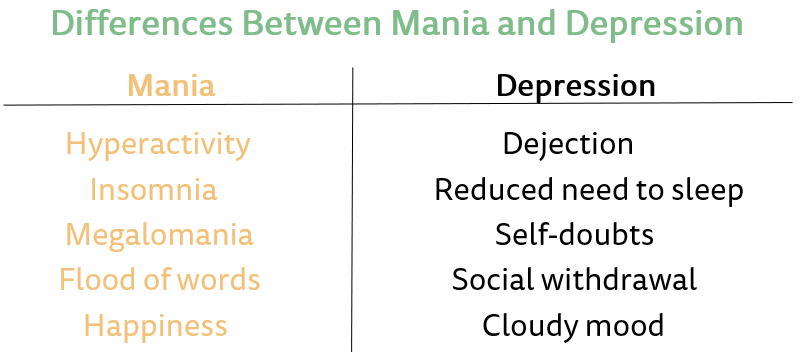Extremely happy in one moment and deeply depressed in the next – People, suffering from a bipolar disorder has extreme changes in their mood. They find themselves either in a feeling of elation, the mania or in depression. That is where the name bipolar comes from. The emotional state changes rapidly in mood, motivation, and level of activation. Depressive alternate with manic episodes and the patient is not able to control all of this. What are the causes of this mental illness? How does a manic-depressive person feel and what to do about it?
According to several estimates, in Germany about 1 to 3 percent of the population is maniac depressive. Both sexes have the same risk. Although the mental disease is mostly diagnosed later in life, the first episode of the illness occurs often around the age of 18. Its progress is episodic and chronical, and the mood swings occur in any situations of life. A manic depression does not occur out of nowhere, it develops slowly and silent.
What are the symptoms of a bipolar disorder?
We all have swings in our mood from time to time. Better days alternate with bad ones, according to this we are not in the same mood permanently. Whereas the mood of a manic-depressive person swings from one extreme to the other. They are driven by mania and depression. In the state of mania, a person feels extremely good, is hyperactive, irritable, and euphoric. After this episode comes depression. Patients feel sad, listless and in a bad mood. Between those extremes there is also a normal state. A unipolar depression has no manic episodes as a symptom
What is the course of a bipolar disorder?
A maniac-depressive person experiences different episodes:
Depressive episode (duration ≥ 2 weeks)
In the depressive episode patients show the same symptoms as in a “common”, or unipolar depression:
- depressed mood
- lack of happiness and interests
- feeling of guilt
- social withdrawal
- sleep disturbances
Manic episode (duration ≥ 1 week)
In the manic episode patients feel extremely happy for no reason. More symptoms are:
- mood swings between happiness and irritability
- hyperactivity, restlessness and urge to move
- megalomania
- flood of words
- reduced need to sleep
- exaggerated opinion of oneself
Hypomania (duration ≥ 4 days)
In a bipolar disease this episode shows like a mania. Even though the symptoms are milder and shorter. So, patients and their daily lives are not influenced by that. They feel healthy, creative, and powerful then.
Mixed state
The mood changes from mania to depression and the other way around. All of this happens within hours and it is also possible, that both moods happen at the same time. Risk of suicide is extremely high in this mixed state.
Here you can find the difference between mania and depression:

What are the causes of a bipolar disorder?
For developing a maniac depression there are many causes.
Biological influences
When suffering from a bipolar depression, the function of brain metabolism is out of balance. There is an imbalance between the neurotransmitters dopamine, GABA, noradrenaline, and serotonin. Furthermore, studies had shown changes in the limbic system. Emotions are felt and regulated in this area.
Genetic factors and bipolar disorder
A maniac depression is not inherited per se. Nevertheless, bipolar disorders occur seven times more in first degree relatives. For a direct offspring the risk of developing the same disorder is at 10 percent. If both parents are affected, the risk increases to about 40 to 50 percent.
Psychosocial influences
There are few social factors, which could build a ground for developing a manic disorder:
- Bereavements
- extreme physical diseases
- sexual abuse
- psychosocial stress (private/job)
That is why a healthy lifestyle is especially important for prevention.
How a bipolar disorder is diagnosed?
Mostly, a bipolar depression is diagnosed only between 5 and 10 years after its beginning. It is not the actual symptoms that are important, it is the clinical history. Therefore, structured questionnaires are used. In the first depressive episode it is not clear if it is a uni or bipolar affective disorder.In the following 9 years around 25 percent go through a manic or hypomanic episode. Sometimes, the symptoms of a mania could also be part of other diseases. Therefore, it is necessary, that psychical causes can be excluded.
What is the treatment of a bipolar disorder?
Manic depression is a lifelong disease, that is why help is so important. Patients do not see that they are mentally ill, when in a manic episode. It is a long way until they accept help from a therapist. In many cases, patients get a combination of psychotherapy and drug therapy. Furthermore, electroconvulsive therapy. Important to mention: Also, early warning signs of a manic or depressive episode should be recognized. Those can be used as steps for prevention.
Even if bipolar depression is a lifelong company: There are options to form this company as pleasant as possible. Psychotherapy, talking to other patients an also drug treatment is supportive. Create your life worth living and admit to yourself, that you do not have to face all your problems by yourself.
Sources:
https://www.nimh.nih.gov/health/topics/bipolar-disorder/index.shtml
https://www.mayoclinic.org/diseases-conditions/bipolar-disorder/symptoms-causes/syc-20355955
https://www.healthline.com/health/bipolar-disorder
https://www.nhs.uk/conditions/bipolar-disorder/
Photo credit: (c) iStock.com/AndreyPopov

